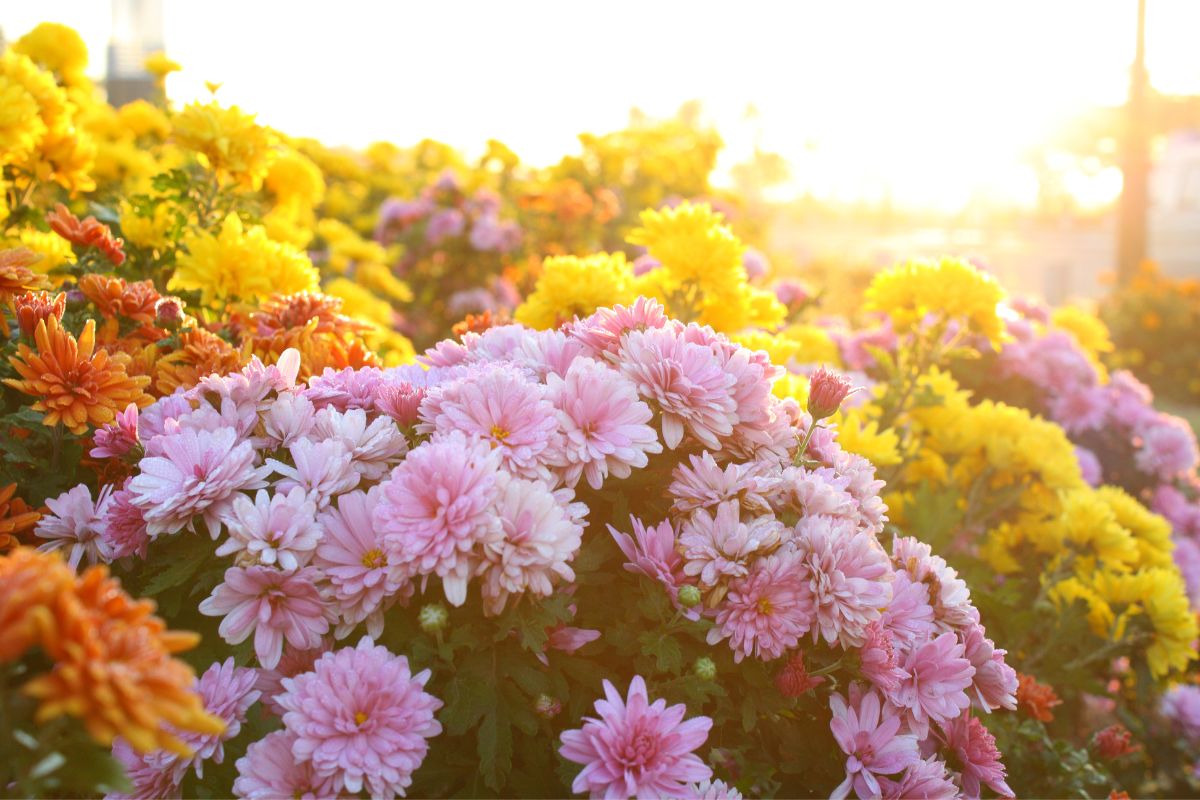Chrysanthemums, also known as mums or chrysanths, are beautiful bright florals that are easy to grow and maintain.
They are popular garden flowers, but they also often feature in bouquets or as houseplants.

There are so many varieties of mums to choose from – in an array of different shapes and colours (pink, red, orange, yellow and even green).
And they are great for new and experienced gardeners alike as they are hardy plants.
Mums are popular fall flowers as they can bloom to September or even October.
While these flowers may be beautiful, there is one thing that can make them unsightly – and that’s when they turn brown.
But why do mums turn brown and hope can you stop this happening?
Mums can turn brown due to disease, poor growing conditions and a few other factors. Let’s learn more below.
Why Are My Mums Turning Brown?
As with any other plant with browning leaves or flowers, there are a few main causes.
Mums will usually turn brown if the growing conditions are not quite right or due to disease or other environmental factors.
Too Much Or Too Little Water
Mums love water, so it’s important they get enough of it.
These thirsty plants should be watered a few times per week to keep them happy.
However, it’s important you don’t give them too much water either.
Overwatering your plants can cause root rot and suffocation, so it’s best to check if the soil is dry before watering them.
And remember that good drainage is important too so that the pot doesn’t hold water.
If your chrysanthemums are dying or turning brown, reassess your watering schedule and scale up or scale back depending on what your plants need.
Sunlight
All plants need sunlight to grow, but too much, or too little can cause problems.
Mums really thrive in full sun so make sure they get plenty of it and you will get more gorgeous blooms as a result.
If you live in a particularly hot clime, however, they may benefit from a little shade during the hottest part of the day to stop them from burning and browning.

Pests
Mealy bugs and aphids enjoy mums, so if your plants are wilting and browning, pests may be to blame.
Not to forget slugs and snails – if they’re munching away at your plant, the blooms will suffer.
Check the stem and leaves of your plant, including the underside of the leaves, to see if you can spot aphids or mealy bugs and treat with a pesticide.
If you’re suffering with slug and snail problems, try adding eggshells to your plant pots.
Soil
Although mums are hardy flowers, they do need to be in good soil to survive.
Try to select good, rich, fertile soil or compost to grow your mums.
You can also feed your mums with plant food from time to time to ensure they’re getting all the nutrients they need.
As I mentioned above, good soil drainage is essential.
So make sure your pot has holes in it and you use a compost mix that allows for good aeration and one that isn’t too heavy to avoid restricting the roots.
Bad Weather
As I said, mums really enjoy the sun. As a result, they don’t fare so well in colder weather.
Hard frost can have a detrimental effect on your chrysanthemums, so if the temperature is predicted to drop earlier than expected in the fall, you may want to give your mums some protection.
It’s worth noting that heavy rainfall or hail can also damage your flowers.
Disease
White rust is probably the most common fungal disease that can affect chrysanthemums.
You can identify this disease by the yellow or white spots on the surface of the mum’s leaves.
Mums can also be affected by brown rust, which is similar to white rust, but you can expect to see brown spots of disease instead.
Weeding your plants regularly and keeping pests at bay are the best way of preventing these diseases, but should your crop succumb to rust, you can purchase chemical treatments.

How Long Do Mums Last?
How long your mums last will depend on the variety you’ve planted, and it will also be dictated by the growing and environmental conditions.
However, as a general rule of thumb, most chrysanthemums will bloom for around 4-8 weeks.
If they start to look worse for wear before this, it may be possible to bring them back to life.
What To Do If Your Mums Are Turning Brown
If only some of your leaves and blooms have started to brown, you can prune these.
If the damage is severe, but it’s still early in the growing season, you may be able to cut the plant back quite a bit to make room for new, healthier growth.
The earlier you can catch and rectify the problem, the better.
It’s important to identify the source of the browning though from the issues listed above and eradicate any further issues to protect the rest of the crop.
Top Tips For Caring For Your Chrysanthemums
The best way to prevent your mums from turning brown is by providing them with the right care.
Follow these tips for healthy chrysanthemums:
- Make sure your mums have access to plenty of sunlight
- Water them regularly but don’t overwater them
- Treat your mums to plant food
- Choose soil with good drainage
- Protect your mums from frost
- Check for pests regularly and treat accordingly
Remember, if you do notice that your mums are turning brown, find and eradicate the problem and prune the plant.
Final Thoughts
Mums are wonderful fall flowers that add stunning shades to any garden.
Although these plants are considered to be pretty hardy, they can have their problems.
If your mums are browning, it’s important to find out why earlier so that you can change the conditions and save the plant.
Proper care from the beginning will help to prevent your chrysanthemums from ever turning brown – keeping your borders bright and bold.
- Can You Grow Bell Peppers Indoors? A Guide For New Gardeners - November 14, 2023
- Composting Basics: Can You Compost Mushrooms? - November 6, 2023
- A Gardener’s Guide To Growing Carrots In Raised Beds - November 1, 2023




